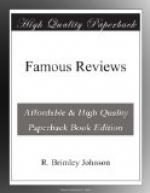Mr. Macaulay announces his intention of bringing down the history of England almost to our own times; but these two volumes are complete in themselves, and we may fairly consider them as a history of the Revolution; and in that light the first question that presents itself to us is why Mr. Macaulay has been induced to re-write what had already been so often and even so recently written—among others, by Dalrymple, a strenuous but honest Whig, and by Mr. Macaulay’s own oracles, Fox and Mackintosh? It may be answered that both Fox and Mackintosh left their works imperfect. Fox got no farther than Monmouth’s death; but Mackintosh came down to the Orange invasion, and covered full nine-tenths of the period as yet occupied by Mr. Macaulay. Why then did Mr. Macaulay not content himself with beginning where Mackintosh left off— that is, with the Revolution? and it would have been the more natural, because, as our readers know, it is there that Hume’s history terminates.
What reason does he give for this work of supererogation? None. He does not (as we shall see more fully by and by) take the slightest notice of Mackintosh’s history, no more than if it had never existed. Has he produced a new fact? Not one. Has he discovered any new materials? None, as far as we can judge, but the collections of Fox and Mackintosh, confided to him by their families.[1] It seems to us a novelty in literary practice that a writer raised far by fame and fortune above the vulgar temptations of the craft should undertake to tell a story already frequently and recently told by masters of the highest authority and most extensive information, without having, or even professing to have, any additional means or special motive to account for the attempt.
[1] It appears from two notes of acknowledgments to
M. Guizot and the
keepers of the archives at
The Hague, that Mr. Macaulay obtained
some additions to the copies
which Mackintosh already had of the
letters of Ronquillo the Spanish
and Citters the Dutch minister at
the court of James. We
may conjecture that these additions were
insignificant, since Mr. Macaulay
has nowhere, that we have
observed, specially noticed
them; but except these, whatever they
may be, we find no trace of
anything that Fox and Mackintosh had not
already examined and classed.
We suspect, however, that we can trace Mr. Macaulay’s design to its true source—the example and success of the author of Waverley. The historical novel, if not invented, at least first developed and illustrated by the happy genius of Scott, took a sudden and extensive hold of the public taste; he himself, in most of his subsequent novels, availed himself largely of the historical element which had contributed so much to the popularity of Waverley. The press has since that time groaned with his imitators. We have had historical novels of all classes and grades. We have had served up in this form the Norman Conquest and the Wars of the Roses, the Gunpowder Plot and the Fire of London, Darnley and Richelieu—and almost at the same moment with Mr. Macaulay’s appeared a professed romance of Mr. Ainsworth’s on the same subject— James II. Nay, on a novelist of this popular order has been conferred the office of Historiographer to the Queen.




